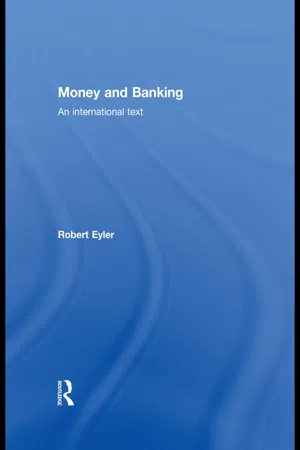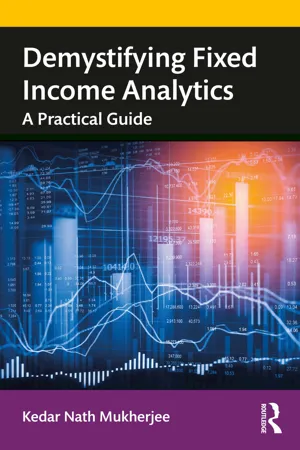Business
Interest Rates in the UK
Interest rates in the UK refer to the cost of borrowing money or the return on savings and investments. They are set by the Bank of England's Monetary Policy Committee and influence business decisions by affecting the cost of capital and consumer spending. Changes in interest rates can impact the profitability of businesses, investment decisions, and overall economic activity.
Written by Perlego with AI-assistance
Related key terms
Related key terms
1 of 4
Related key terms
1 of 3
4 Key excerpts on "Interest Rates in the UK"
- MONETARY POLICY COMMITTEE at the Bank of England. See also BASE RATE .interest the charge made for borrowing money in the form of a LOAN . Interest is payable on a number of short-term and long-term borrowing forms, including BANK LOANS, MORTGAGES, INSTALMENT CREDIT, LEASING, LOAN STOCK, DEBENTURES, BONDS, TREASURY BILLS and BILLS OF EXCHANGE . Lenders require a NOMINAL INTEREST RATE that compensates them for the effects of INFLATION in reducing the PURCHASING POWER of any sums that they lend, so that the real or EFFECTIVE INTEREST RATES provide an adequate reward to lenders for forgoing current consumption and for the risk of default introduced in lending out money.In aggregate terms, interest is a source of income and is thus included as part of NATIONAL INCOME . In the THEORY OF SUPPLY , interest is a payment for the use of CAPITAL as a FACTOR OF PRODUCTION . See INTEREST RATE .interest cover an accounting measure of the extent to which a firm’s earnings cover INTEREST payments due on LOANS that expresses profit after tax as a ratio of interest due.interest rateThe particular amount of INTEREST that a household or business borrower is required to pay to a lender for borrowing a particular sum of money to finance spending on CONSUMPTION and INVESTMENT .The level of interest rates is determined by the forces of demand and supply for finance in the MONEY MARKET and the application of MONETARY POLICY by the authorities. The cheaper the cost of borrowing money, the more money will be demanded by households and businesses. The higher the rate of interest, the greater the supply of loanable funds. The ‘equilibrium’ rate of interest is determined by the intersection of the demand for (Dm), and supply of (Sm ), loanable funds – interest rate R in Fig. 95 (a). In theory, the monetary authorities can control the rate of interest by changes in the MONEY SUPPLY . If the money supply is increased from Sm to Sm1 , the effect would be to lower the equilibrium rate of interest from R to R1 , and through the rate of interest the level of total spending (AGGREGATE DEMAND ) in the economy. (See MONEY SUPPLY /SPENDING LINKAGES
- eBook - ePub
Money and Banking
An International Text
- Robert Eyler(Author)
- 2009(Publication Date)
- Routledge(Publisher)
2 Interest rates and financial marketsIntroduction
Interest rates represent prices of every economic action because they represent both opportunity costs for the use of goods, services and inputs and connect time periods to each other. The sacrifice of consumption today must come with a reward, and consuming today must have its cost. There are many interest rates, one for every asset that exists. The “price” of an asset is in part determined by an interest rate. Interest rates are used in business plans to discount the future, as income to those who have deposited money, purchased stocks and bonds, and to those who make a loan. It is a cost to those who borrow, the cost of consuming more than you can afford at a given time. It is also the cost of not buying something that could produce income. We can summarize the interest rate’s definition generally in four ways:• The revenue from lending or not consuming; • The cost of borrowing or consuming; • The opportunity cost of holding money as cash; and • A measure of time preference concerning consumption.Interest rates come in many forms, all with the same basic set-up. An interest rate includes measures of risk, both general and very specific. When you borrow money, the rate at which you borrow is the nominal rate. This rate is the stated interest cost or return of a financial investment. There is also a real rate, but what separates the two? The difference between nominal and real variables in economics has to do initially with inflation, or purchasing power erosion, and other risks. In its most basic form, a nominal interest rate has the following equation:R = r + P(2.1) where R is a nominal rate, r is the associated real rate and P - eBook - ePub
Commercial Lending
Principles and Practice
- Adrian Cudby(Author)
- 2018(Publication Date)
- Kogan Page(Publisher)
above base rate. This margin will be for the term of the loan or overdraft and will remain at the same rate throughout the life of the loan. For example, at a margin of 3 per cent above base and a base rate of 0.5 per cent, the full rate paid by the customer is 3.5 per cent. However, what remains a variable is that base rate can alter, up or down, through the life of the loan. If the Bank of England decides to raise interest rates (to control inflation, for example) then the customer has no option but to pay the increased costs on their loan. This could be for the rest of the term of the loan. Banks will therefore often model serviceability against a predetermined ‘default rate’ to give a through the cycle view of serviceability.A small rise in base rate may not appear on the face of it to be too onerous; however, it needs to be put in context with each customer. For every £1 million borrowed by a commercial customer, a rise in base rate of 0.5 per cent creates an extra £5,000 per annum in interest costs. The immediate impact of any rise in interest rates is a reduction in profits and also an impact on the cash position of the business. Most loans have interest applied on a quarterly basis and therefore it is likely that the bank will very quickly increase the monthly or quarterly repayments following an increase in base rate to ensure that the loan is repaid within the original term.Interest ‘roll-up’
Interest roll-up is a technique that the bank can employ when it is lending to customers who require a period of time to undertake the development of a new project. For example:- residential property development;
- building of a new factory; or
- building of a new care home.
Funds for this type of venture will be lent on a phased basis against agreed milestones (and usually with the involvement of other professionals such as monitoring surveyors). Repayments will not start until the development has completed and is in a position to start generating profits. The logic behind having interest ‘rolling up’ is that there is no income being generated during the development phase to cover it. Such a lending strategy will be subject to an agreed exit event, often linked to an asset disposal. It is therefore essential that there is sufficient headroom in the value to cover both the capital and accruing interest. - eBook - ePub
Demystifying Fixed Income Analytics
A Practical Guide
- Kedar Nath Mukherjee(Author)
- 2020(Publication Date)
- Routledge India(Publisher)
The interest rate is the rate that is charged or paid for the use of money and is expressed as an annual percentage of the principal. From an investor’s perspective, the interest rate is the annual return which he/she generates from her/his investment. Interest rate can be of two types: nominal and real interest rates. Nominal interest rates are normally positive, but real interest rates can be negative, depending upon the economic situation, especially the rate of inflation. The interest rate may change because of several factors; such as: inflationary expectations, alternative investments, risk of investment, liquidity preference, tax implication, and most importantly the maturity or period. Depending upon the length of the period, interest rates could be short term (with less than one-year term) and long term (or a maturity above 1 year). In some cases, there could be some rates of medium term with a maturity between one to 5/10 years. Some important short-term rates are: interbank call rates of different maturity (LIBOR/MIBOR with 1-day, 1-month, 3-month, 6-month, 1-year); 1-day, 7-day, 14-day, 1-month repurchase (Repo) rates; 3-month, 6-month, 12-month deposit/lending rates, 91-day, 182-day, 364-day T-bill rates; short-term swap rates, etc. On the other hand, some of the long-term rates include: yield on long-term government securities, corporate bond yields, bank lending rates, long-term swap rates, etc.Some important interest rates in Indian debt marketBenchmark rateThe benchmark interest rate, alternatively known as base interest rate, is the minimum interest rate that investors will demand for their non-governmental investment, say a non-Treasury security. It is also tied to the yield to maturity offered on on-the-run (most recently issued) Treasury security of comparable-maturity. Alternatively, a benchmark rate is an interest rate against which other interest rates are calculated. For example, a benchmark rate could be the interest rate at which the central bank of an economy (here RBI) gives loans (borrows money) to (from) the commercial banks under their jurisdiction, which further can be used as a benchmark by the commercial banks to decide the interest rate for their loan or deposit products of different maturity. The interest rate at which commercial banks and other selected FIs can borrow (lend) money from (to) the Reserve Bank of India is called Repo Rate (Reverse Repo Rate), which is presently (as on December 2019) at 5.15% (4.90%). At the same time, the other benchmark rate, offered by the central bank, in India is the Marginal Standing Facility (MSF) Rate, and Bank Rate, which is presently (as on December 2019) at 5.40%. In the case of borrowing under Repo from RBI through the Liquidity Adjustment Facility
Index pages curate the most relevant extracts from our library of academic textbooks. They’ve been created using an in-house natural language model (NLM), each adding context and meaning to key research topics.
Explore more topic indexes
Explore more topic indexes
1 of 6
Explore more topic indexes
1 of 4



